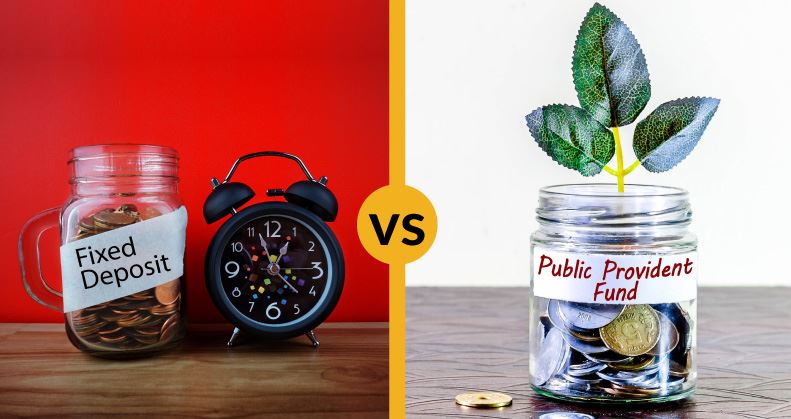If we talk about secure investments in India, FD and PPF are the most popular choices. But often, it is difficult to decide which of the two is a better option. When you are building your portfolio, it is always recommended that you choose different types of assets for different types of returns. As an investor, it is important to understand the basic features of an asset to make the right choice.
This article deals with the difference between Public Provident Fund and Fixed Deposit, which will help you decide which one to choose based on your individual requirement. Before that, let us first understand what FD and PPF are.
Fixed Deposit (FD)
Fixed deposit is an investment option offered by banks and non-banking financial companies, with interest rates decided by the bank based on repo rates. The returns of an FD are not influenced by market fluctuations. It is one of the safest savings instruments, where an investor can deposit a lump sum amount for a fixed tenure to earn a fixed interest rate. If you are thinking of investing in an FD, use an FD calculator to determine the interest rate and the maturity amount you will get for your deposit over the tenure of the FD.
Public Provident Fund (PPF)
PPF is a long-term investment plus tax-saving instrument with backing from the government. It was introduced by the government to promote savings among salaried individuals. The interest rate is decided by the government, and the scheme is offered by the banks and the Indian post office. As it is guaranteed by the government, the scheme is completely secure and also offers tax deductions. An online PPF calculator can be used to get an estimate of the interest earned and the maturity amount for a given invested amount.
Comparison Between FD and PPF
- Amount Invested – In an FD, there is no limit to the amount you can invest. It mostly depends on the bank’s policy. Some banks accept large investments. However, the minimum investment in an FD ranges from Rs. 100 to Rs. 1000. In a PPF, the maximum deposit you can make in a year is Rs. 1.5 lakh, and the minimum deposit is Rs.500.
- Interest Rates – FDs offered by most banks have an interest rate in the range of 3% to 8%. Senior citizens get higher interest rates. The FDs offered by various companies offer higher interest rates that range between 8% to 10%, with higher risks associated with them as well. The interest rate on PPFs is decided by the government and is currently 7.1% p.a.
- Tenure – FDs come with flexible tenure, where you can invest money for 7 days to 10 years as per your choice. So it offers both short-term and long-term investment. On the other hand, PPFs are long-term investments only. The investment in a PPF is locked for 15 years, and an investor cannot choose or modify the investment tenure.
- Income Tax Benefit – The interest earned on an FD is taxable. However, there are tax-saving FDs that offer tax exemptions. PPF investments are fully tax-exempt. The investments made, interest earned, and withdrawals made are all completely tax-free.
- Loan Against Deposit – An investor can avail of a loan against an FD at any time upto 90% of the deposit value. There is no lock-in period, which helps in meeting any sudden or urgent fund requirement. A PPF deposit loan can be availed only after a lock-in period of 3 years.
- Early Withdrawal – A withdrawal before maturity is called early or pre-mature withdrawal. An investor can prematurely withdraw the invested amount from an FD on payment of a penalty. In such a case, the interest is not earned exactly as decided at the time of deposit. In a PPF, premature withdrawals can be made only after 5 years, and the amount of withdrawal is also limited.
Where to Invest FD or PPF?
The answer to this question depends on your individual requirements and financial goals. If you are looking for a flexible and more liquid investment, then FD is the right choice which allows a short-term investment. But if you want tax benefits and are planning for retirement, a PPF is a more promising investment for the long term. The ideal choice is a mix of both that gives you the flexibility to liquidate in the time of need and also stability of future long-term savings.







